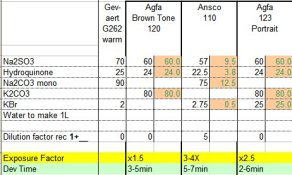grainyvision
Subscriber
Note: This kinda started from the chlorohydroquinone thread, but then I figured out that this is all possible with regular easily available hydroquinone!
This is prototype test #2 formula for GVW1, a special very warm tone print developer which produces brown warm tones. It also is very unique in its action in a way which can make age fogged papers to become usable again.
Note! I do not consider this formula "done" but wanted to start a thread to discuss this early if anyone wanted to replicate the results or suggest improvements to it. I know hydroquinone only print developers are incredibly rare. I've only seen one other HQ only print developer (other than lith developers) which did not produce good results on modern papers.
* 800ml water
* 17g sodium sulfite
* 20g hydroquinone
* 0.3g potassium bromide
* 10.2g sodium bicarbonate (baking soda)
* 26g potassium carbonate
* Top to 1L with water
* pH aim: 10.2 with ~0.3M molarity for the carb/bicarb buffer
* Note: extremely sensitive to bromide, too much will massively slow down development and even cause fog.
* Note: too much sulfite will cause decreased black depth. Too little will cause lith type effects.
* Note: Shelf life is predicted to be poor. Likely stable for 2 weeks or so. Tray life is good otherwise though, no difference in results seen after several hours and 15 sheets of 8x10.
Use undiluted, developing for 1-4m depending on the type of paper and contrast aims.
Over expose by 1/2 stop and for 1/2 grade more contrast compared to other developers. Recommended to pull before development is complete. For most papers there will be 2 distinct phases. One phase where the image comes up but is somewhat low contrast. The 2nd phase the contrast suddenly increases and it is like a veil of fog is lifted. Once in this 2nd phase, leave in longer for darker and colder shadows, less time for browner tones. Contrast can be drastically lowered by over exposure and early pulling, printing negatives aimed for salt prints worked well with this technique
Highly recommend to use fresh stop bath so that development is stopped exactly when needed. The stop bath may be neutralized more quickly than with other developers due to high degree of buffering.
Test photo on Fomatone (not classic) FB, grade 3.5

Kodabrome II RC, unpreserved and expired in the 80s. Top square is unexposed test sheet of the paper developed in Dektol (mild grey), in contrast to a complete image with GVW1. Contrast is a bit weird (I needed grade 4 paper, this is grade 3) but still capable of decent results with proper black tones and cleared highlights

Note: I tried the prototype #1 formula (must less active, pH ~9.7) with film which also gave results worth potentially investigating. Most sources seem to say hydroquinone only developers would cause a speed decrease, but that was not apparent in my test case. Contrast was high due to over development, but I also developed some Tri-X Pan from 1960 in it which came out with only a slightly more grey base than FP4. Grain was surprisingly fine with Tri-X due to it being effectively pulled to ~ ISO 64, and with the FP4 grain was extremely sharp, resembling rodinal. It could definitely be an interesting developer to use for in-camera alt process work at box speed or pushed speed as it was capable of very high contrast at increased speeds without significant loss of shadow detail. Adding PEG to the developer would likely prevent highlights from blowing out as well.
This is prototype test #2 formula for GVW1, a special very warm tone print developer which produces brown warm tones. It also is very unique in its action in a way which can make age fogged papers to become usable again.
Note! I do not consider this formula "done" but wanted to start a thread to discuss this early if anyone wanted to replicate the results or suggest improvements to it. I know hydroquinone only print developers are incredibly rare. I've only seen one other HQ only print developer (other than lith developers) which did not produce good results on modern papers.
* 800ml water
* 17g sodium sulfite
* 20g hydroquinone
* 0.3g potassium bromide
* 10.2g sodium bicarbonate (baking soda)
* 26g potassium carbonate
* Top to 1L with water
* pH aim: 10.2 with ~0.3M molarity for the carb/bicarb buffer
* Note: extremely sensitive to bromide, too much will massively slow down development and even cause fog.
* Note: too much sulfite will cause decreased black depth. Too little will cause lith type effects.
* Note: Shelf life is predicted to be poor. Likely stable for 2 weeks or so. Tray life is good otherwise though, no difference in results seen after several hours and 15 sheets of 8x10.
Use undiluted, developing for 1-4m depending on the type of paper and contrast aims.
Over expose by 1/2 stop and for 1/2 grade more contrast compared to other developers. Recommended to pull before development is complete. For most papers there will be 2 distinct phases. One phase where the image comes up but is somewhat low contrast. The 2nd phase the contrast suddenly increases and it is like a veil of fog is lifted. Once in this 2nd phase, leave in longer for darker and colder shadows, less time for browner tones. Contrast can be drastically lowered by over exposure and early pulling, printing negatives aimed for salt prints worked well with this technique
Highly recommend to use fresh stop bath so that development is stopped exactly when needed. The stop bath may be neutralized more quickly than with other developers due to high degree of buffering.
Test photo on Fomatone (not classic) FB, grade 3.5

Kodabrome II RC, unpreserved and expired in the 80s. Top square is unexposed test sheet of the paper developed in Dektol (mild grey), in contrast to a complete image with GVW1. Contrast is a bit weird (I needed grade 4 paper, this is grade 3) but still capable of decent results with proper black tones and cleared highlights

Note: I tried the prototype #1 formula (must less active, pH ~9.7) with film which also gave results worth potentially investigating. Most sources seem to say hydroquinone only developers would cause a speed decrease, but that was not apparent in my test case. Contrast was high due to over development, but I also developed some Tri-X Pan from 1960 in it which came out with only a slightly more grey base than FP4. Grain was surprisingly fine with Tri-X due to it being effectively pulled to ~ ISO 64, and with the FP4 grain was extremely sharp, resembling rodinal. It could definitely be an interesting developer to use for in-camera alt process work at box speed or pushed speed as it was capable of very high contrast at increased speeds without significant loss of shadow detail. Adding PEG to the developer would likely prevent highlights from blowing out as well.
Last edited:







